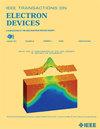Investigation of Nanoscale Bonding-Based Complementary FETs
IF 3.2
2区 工程技术
Q2 ENGINEERING, ELECTRICAL & ELECTRONIC
引用次数: 0
Abstract
In this article, the nanoscale bonding-based complementary field-effect transistor (B-CFET) is proposed as a high-performance alternative to sequential CFETs (S-CFETs) for next-generation technology nodes. Unlike S-CFETs, which suffer from thermal budget constraints that lead to junction abruptness degradation, B-CFET mitigates these issues by employing low-temperature bonding techniques for CFET integration. This approach enables the use of heterogeneous channel materials and allows independent nMOS/pMOS optimization. To assess its performance feasibility, B-CFET is compared with S-CFET. 3-D TCAD simulations indicate that, when accounting for the junction abruptness degradation of S-CFET’s bottom transistor due to dopant diffusion (assuming an increase of 1 nm per decade), B-CFET achieves an 11.1% improvement in operating frequency at the same leakage power (纳米级键合互补场效应管的研究
本文提出了基于纳米级键合的互补场效应晶体管(B-CFET),作为下一代技术节点的顺序cfet (s - cfet)的高性能替代方案。与s -CFET不同,s -CFET受到热预算限制,导致结的突然性下降,B-CFET通过采用低温键合技术集成CFET,减轻了这些问题。这种方法可以使用异质通道材料,并允许独立的nMOS/pMOS优化。为了评估其性能可行性,将B-CFET与S-CFET进行了比较。三维TCAD仿真表明,考虑到S-CFET底部晶体管由于掺杂扩散导致的结度衰减(假设每10年增加1 nm),在相同泄漏功率(${f}_{\text {ISOLEAK}}\text{)}$下,B-CFET的工作频率比S-CFET提高了11.1%。虽然额外的键合凹凸层会延长垂直互连或导致错位和空隙形成,潜在地增加外部电阻,但分段电阻分析表明,这些因素对整体性能的影响可以忽略不计。即使在极端条件下,当结合电阻从17.5显著增加到$60.7~\Omega $(增加247%)时,B-CFET也表现出出色的鲁棒性,在${f}_{\text {ISOLEAK}}$中仅下降1.0%。这种最小的退化突出了(${R}_{\text {BUMP}}\text{)}$对整体性能的影响可以忽略不计,并增强了其作为未来cfeet技术的可扩展和弹性架构的潜力。
本文章由计算机程序翻译,如有差异,请以英文原文为准。
求助全文
约1分钟内获得全文
求助全文
来源期刊

IEEE Transactions on Electron Devices
工程技术-工程:电子与电气
CiteScore
5.80
自引率
16.10%
发文量
937
审稿时长
3.8 months
期刊介绍:
IEEE Transactions on Electron Devices publishes original and significant contributions relating to the theory, modeling, design, performance and reliability of electron and ion integrated circuit devices and interconnects, involving insulators, metals, organic materials, micro-plasmas, semiconductors, quantum-effect structures, vacuum devices, and emerging materials with applications in bioelectronics, biomedical electronics, computation, communications, displays, microelectromechanics, imaging, micro-actuators, nanoelectronics, optoelectronics, photovoltaics, power ICs and micro-sensors. Tutorial and review papers on these subjects are also published and occasional special issues appear to present a collection of papers which treat particular areas in more depth and breadth.
 求助内容:
求助内容: 应助结果提醒方式:
应助结果提醒方式:


